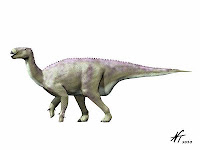Iguanodon was the second dinosaur formally named, after Megalosaurus. Iguanodon teeth are, as the name suggests, similar an iguana, but larger. Unlike hadrosaurids, which had columns of replacement teeth, Iguanodon only had one replacement tooth at a time for each position.
The largest find of Iguanodon remains to date was discovered in 1878 in a coal mine at Bernissart in Belgium; at a depth of 1056 feet (322 metres), at least 38 individual skeletons were found, most of which were adults. This amount of Iguanodon remains is quite significant but in comparison to today’s animals that roam the plains such as the herds of gazelle or zebra which reach thousands in groups, this seems a small amount.
It was first discovered in 1822 in Sussex and described three years later by English geologist Dr Gideon Mantell. It had a spike on each thumb which may have been used for defence, this thumb spike was one of the most distinctive features of Iguanodon. The spike was originally thought to have been a nose spike similar to today’s living rhinoceros. In London at the Crystal Palace park you can see the interpretation of what Mantell believed Iguanodon may have looked like when alive because there are several concrete statues of Iguanodon and this includes the thumb spike portrayed on the nose. Iguanodon is also posed as quadrupedal and was believed to have just waked on all four but this was changed to believing that Iguanodon walked on two legs, it is now widely accepted that Iguanodon could shift from bipedality to quadrupedality. Many footprints and track ways have been discovered of Iguanodon.
- Name
- Iguanodon bernissartensis
- Authority
- Iguanodon, Mantell (1825) bernissartensis, Boulenger (1881)
- Meaning of generic name
- Iguana Tooth
- Meaning of specific name
- From Bernissart
- Size
- Length: 10 m
- Remains
- Several articulated and associated skeletons, several skulls, teeth and isolated bones
- Age and Distribution
- Wessex Formation (Barremian-Aptian), Isle of Wight, England. (Aptian), Bernissart, Belgium.
- Classification
- Dinosauria Ornithischia Cerapoda Ornithopoda Iguanodontidae
- Further Reading
- Naish, Darren; David M. Martill (2001). "Ornithopod dinosaurs". Dinosaurs of the Isle of Wight. London: The Palaeontological Association. pp. 60–132.
- Images by Nobu Tamura (click to enlarge):
Iguanodon bernissartensis [from January 27, 2013]: 
[from July 20, 2011]: 
No comments:
Post a Comment